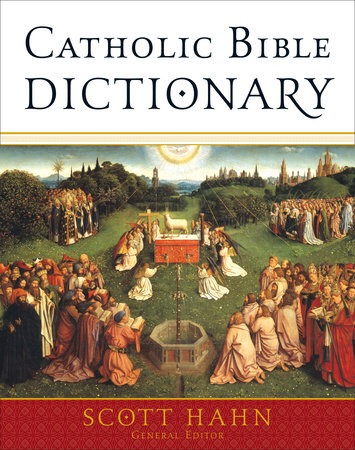Excerpt
Catholic Bible Dictionary
PREFACE A dictionary is, by definition, a reference book listing terms important to a particular subject along with a discussion of their meanings and applications.
If the Bible is what Christians say it is, can there be any task more daunting than the compiling of a Bible dictionary? For we believe that the Bible is the written Word of God. We believe it is “inspired by God” (2 Tim 3:16). We believe it is not a dead letter, but “living and active” (Heb 4:12). We believe it “must be fulfilled” (Luke 22:37) and “cannot be broken” (John 10:35). What’s more, it is not subject merely to private interpretation (2 Pet 1:20), but to the discernment of the Church. For people can easily “twist” Scripture “to their own destruction” (2 Pet 3:16).
The Bible is as sharp as any two-edged sword (Heb 4:12), and thus it should be handled with care.
Yet it should indeed be handled. The Bible itself exhorts us to attend to its study (1 Tim 4:13) and praises those who “examine the Scriptures daily” (Acts 17:11).
We live in a time of unprecedented opportunities for Bible study. In the 1970s the Catholic Church revised its lectionary—the order of scriptural readings for the Mass. The readings now unfold in a three-year cycle and include all the books of both testaments of the Bible. The schema proved so effective in communicating the Word of God that it has been adopted and adapted by many Protestant bodies as well. Historians may one day judge the new lectionary to be the most significant ecumenical advance of the twentieth century.
The Mass is the one thing that Catholics experience on a weekly basis all their lives, and the Bible is the one book that they will hear at every Mass. Since Masses on Sundays and holy days usually include three readings from the two testaments, plus a fourth from the book of Psalms, the average faithful Catholic spends about fifteen hours a year in focused Bible study. If you include the other overtly biblical parts of the Mass (the “Holy, Holy, Holy,” the “Lamb of God,” the “Lord, Have Mercy,” and so on), the average time per annum doubles or triples. For the Catholic who goes to daily Mass, the times are quite impressive, rivaling even the hours spent by some scholars.
What does the lectionary mean, practically speaking? It means that Catholics who keep to their minimum obligations—attendance at Mass on Sundays and holy days—are immersed in the Bible. What’s more, since the lectionary itself is held in common by a growing number of Christians, we find that Catholics and Protestants may find, more and more, that they are “on the same page,” so to speak.
The lectionary is the greatest, but surely not the only great new opportunity for Bible study. The Bible is not only fully divine, but also fully human; and so we have to work with its literary sense and historical background in order to get to the theological meaning. And, again, we are blessed to live in a season of abundance.
Of the making of new books—and Bibles— there is no end. Publishing in the fields of biblical studies and translation is at an all-time high. The airwaves are thick with television and radio shows that claim to represent a biblical worldview. Software packages enable us to search the Scriptures with the speed and accuracy that ancient monks imagined to be impossible this side of heaven.
Yet even with all these tools, major longitudinal studies seem to indicate that biblical literacy—among all Christians—is not advancing, but declining. Thus, there is a widespread need for a fresh statement of the basic terms we encounter in reading the Bible.
More than a generation has passed since the appearance of the last major Catholic Bible dictionary. It has been a fertile generation for biblical scholarship. It has been an eventful time for biblical archaeology. It has been a fruitful time for the Church’s interpretation of the Bible. It is time for a new resource. I pray that my colleagues and I have lived up to our task. I pray, too, that our readers will live up to theirs.
In this book, our range is catholic and inclusive, and so we privilege the Church’s ancient canon, which was ratified at the Council of Trent. We treat the “deuterocanonical books”—Tobit, Baruch, Judith, Wisdom, Ecclesiasticus (Sirach), 1 Maccabees, and 2 Maccabees—as inspired Scriptures. We also recognize the longer forms of Daniel and Esther. We have been pleased to assimilate the great contributions of historical-critical scholarship, but we have also relied upon the Church’s interpretive tradition and Magisterium.
Responding to the call of the magisterium, we have produced this book. The Church, after all, “forcefully and specifically exhorts all the Christian faithful . . . to learn the surpassing knowledge of Jesus Christ, by frequent reading of the divine Scriptures.” So says the Catechism of the Catholic Church, and then it concludes by quoting the great Scripture scholar of the first millennium, St. Jerome:
Ignorance of the Scriptures is ignorance of Christ.
~Scott W. Hahn, Ph.D. September 30, 2008 Feast of St. Jerome~




